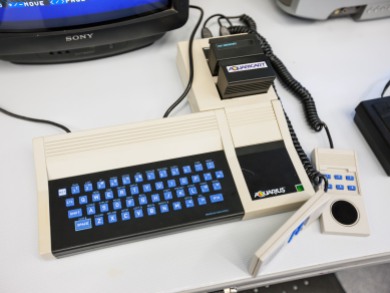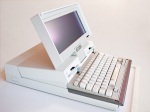
I have one definite project that I want to complete this year, building a multi-boot bridge machine. This is more of an enabler than a full on retro project and will likely prove far from taxing, hopefully taking only a few hours.
Once achieved however it will allow me to seriously de-clutter my workspace and this in turn will hopefully allow me to get on with some other retro goodness without the continual hindrance of being surrounded in junk.

Choice Of Cases
Due to the ubiquitous nature of MS-DOS and the various subsequent flavours of Windows most of the retro computers in my collection rely on connecting to Wintel machines to facilitate file transfers. Some of the software provided is very specific about which version of DOS/Windows it will play ball with. I therefore have a collection of machines running early versions of DOS through to Windows XP. My aim is to narrow this down to one machine.
Helpfully Microsoft still provide minimum specifications for Windows For Workgroups and XP.
Windows For Workgroups:-
- 80286 microprocessor or better for version 3.1
- 80386sx microprocessor or better for version 3.11
- 2048 kilobytes (K) total memory for version 3.1
- 3 megabytes (MB) total memory for version 3.1 (2 MB with no network installed)
- 3 megabytes (MB) total memory for version 3.11 (4 MB is recommended)
- 6.2 MB of hard drive space (14.5 MB recommended)
Windows XP:-
- Pentium 233-megahertz (MHz) processor or faster (300 MHz is recommended)
- At least 64 megabytes (MB) of RAM (128 MB is recommended)
- At least 1.5 gigabytes (GB) of available space on the hard disk
- CD-ROM or DVD-ROM drive
- Keyboard and a Microsoft Mouse or some other compatible pointing device
- Video adapter and monitor with Super VGA (800 x 600)or higher resolution

Choosing A Motherboard
I delved in to my collection of motherboards and cases and decided to pair an Abit BH6 motherboard with a 300 MHz Pentium 2 ripped from a dead Dell Dimension. The BH6 has a good combination of ISA and PCI slots, USB, standard serial and parallel ports. It’s had an interesting few years, some of them spent hanging on the wall as decoration (regularly vacuumed in a non sympathetic manner) and the last 2 or 3 in a pile of other MBs in a damp, non heated shed. I was therefore a little sceptical as to whether it would still work.
I also found an Nvidia TNT 2 graphics card, two 128MB sticks of PC100 RAM, a 3.5″ FDD and a CD-ROM drive. I assembled all of the components into a suitable case and was somewhat surprised when greeted by a successful POST.

Compact Flash Cards
I decided in advance that the easiest way to boot into various OS’s would be to use Compact Flash cards. I have a number of them lying around in various sizes from 32MB up to 16GB and have had great success with them in the past.
I had therefore ordered an IDE to CF adapter with a back plate fitting so that the card could be swapped out easily. In retrospect a 5.25 Bay model would have been even more convenient so I may yet get one of those.

CF Adapter
Once fitted and hooked up with a suitable cable I set about installing Windows for Workgroups, Windows 95 and 98 onto separate cards. The installations went pretty smoothly, I put DOS 6.22 and WFW on a 32 MB card, Windows 95 on a 1 GB card and 98SE on a 4 GB card. One other useful aspect of this method is that the cards can be easily removed and inserted into a card reader on another machine allowing easy transfer of files.

Installing Windows For Workgroups
Having discovered some old floppy disks whilst rooting around for components for this machine it wasn’t long before it was called in to action. I installed a 5.25″ FDD into a spare bay and inserted the Windows 95 CF card. Once booted into Windows 95 I set about attempting to recover some old files as detailed here.
The build has therefore been successful, I’ll also do an XP installation and then I’ll be able to simply swap cards and boot into whichever OS I need. I shall also add an internal CF adapter with a 4 GB CF card onto which I will install all of the retro software that I need so that it’s always available to each OS.

Pentium II & Heatsink
The machine is reasonably quiet as the Pentium is passively cooled although the graphics card has a small fan, I may therefore root around for a fan-less model.
A sound card would be nice but not essential and I may see if I can hook up the two Voodoo 2 3D cards that I used to run in SLI mode.







































